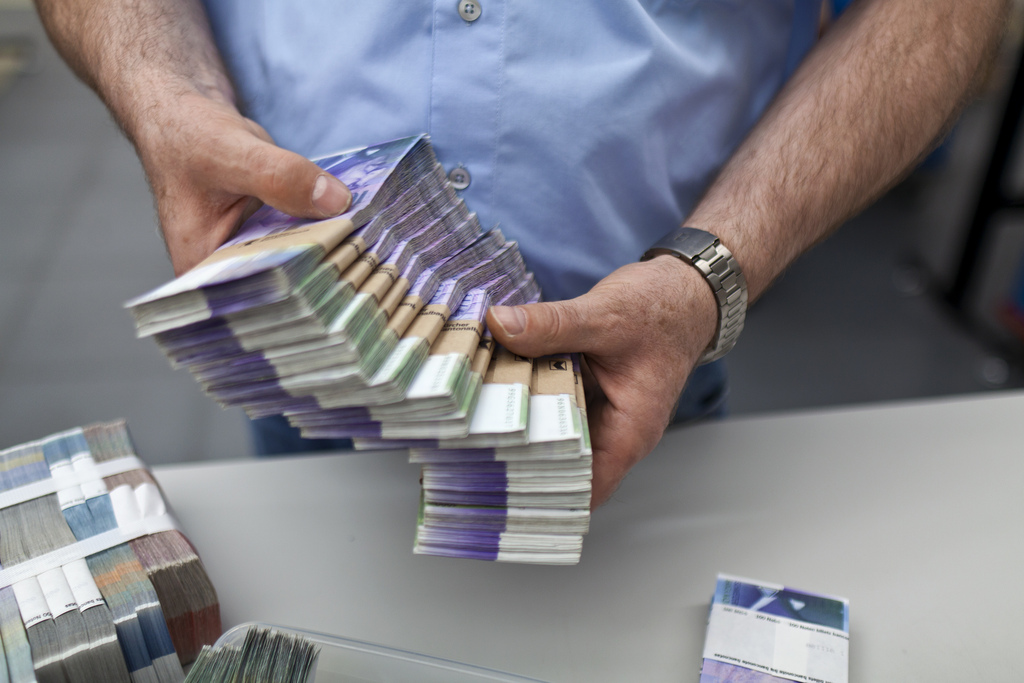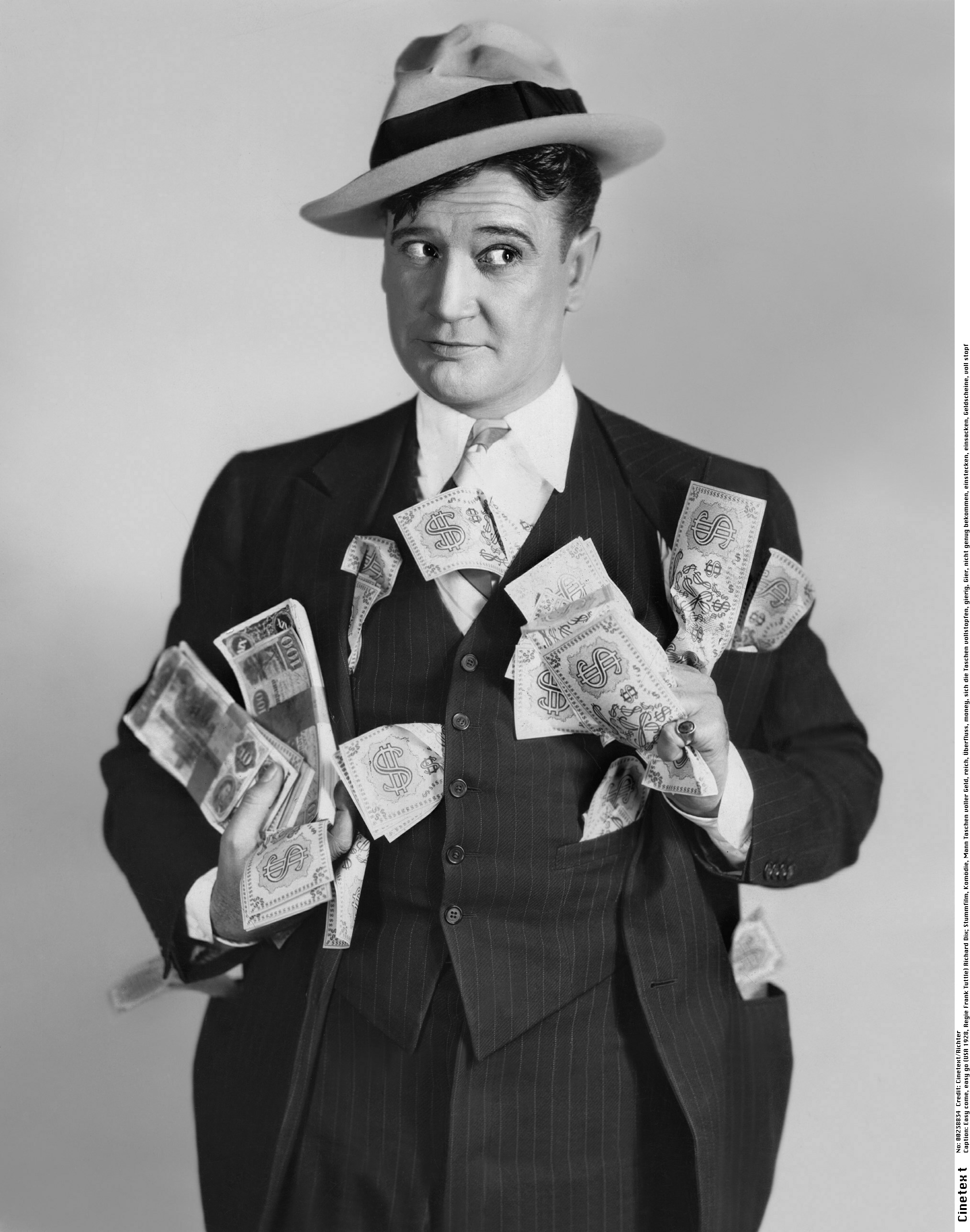Thousand-franc note is a hidden treasure

The use of the Swiss thousand-franc bill is on the rise. Despite its apparent popularity – it makes up almost one in ten Swiss banknotes – few people ever lay their hands on one.
The total value of all CHF1,000 ($1,070) notes in circulation was more than CHF35 billion in 2012. Their share in the CHF55 billion total of all Swiss banknotes rose to a record 60 per cent last year from 50 per cent a year earlier.
As a comparison, only a third of all euros are circulating in the highest denomination €500 (CHF613) bills, and those have already alarmed crime-fighting organisations and authorities. In Switzerland, there is – officially at least – little concern.
Swiss banknote circulation is the second highest in the world behind Japan and more than double that in the United States or the euro zone. Swiss National Bank spokeswoman Silvia Oppliger explains this by the fact that holdings and use of cash remain popular, and that many people still withdraw cash in order to pay their bills at the post office counter.
“People consider using banknotes to be very practical. Also, the wish for privacy has always been high in Switzerland,” Oppliger said. “Using cash for payments is one manifestation of this. This popularity of cash payments is no indication for illegal usage.”
High denomination
The violet thousand-franc bill depicting the face of 19th century art historian Jacob Burckhardt is the banknote with the second-highest denomination in the world, right behind Singapore’s S$10,000 (CHF7,355), and ahead of the €500 bill.
Officially, the high circulation and denomination of the Swiss currency are no issue. The Money Laundering Reporting Office (MROS) of the Federal Office of Police (fedpol) says it does not know the denomination of the notes in the transaction it is investigating.
“From time to time, cash transactions are reported to the MROS. The financial intermediaries, however, report the sum and not the denomination,” said fedpol spokesman Alexander Rechsteiner. “Fedpol is concerned about the black economy in general; the denomination of the cash involved doesn’t play a role.”
Still, the franc’s top face value makes it possible to hoard – or transport – large amounts in a small space. A 10-centimetre pile of notes worth CHF1 million weighs one kilogramme and has a volume of 1.3 litres – half the euro’s volume, according to the website 1,000,000-euro.de. In comparison, $1 million weighs 10 kilos, €1 million about two kilos.
According to the money laundering legislation dated 2010, Swiss banks have to cross-check the authenticity of information provided by the customer for any transfer over CHF25,000. If a customer is connected to criminal activity, there will be an investigation, which may lead to an inquiry into tax fraud, insider trading or terrorist financing.
The Swiss Money Laundering Reporting Office (MROS), which is part of the Federal Police, in 2012 received suspicious activity reports over CHF3.2 billion with suspicious business connections mainly located in Zurich, Geneva and in Ticino, the canton bordering Italy.
If people want to make a secret transaction, they often opt to pay cash – for which there is no record – because there is less traceability than if they paid with direct debit or credit cards.
Criminal use
British bank wholesalers agreed to stop selling the €500 euro note back in 2010 after an investigation by the Serious Organised Crime Agency (SOCA) in Britain found that nine out of ten of the pink notes were used by criminals for illegal activities such as bribes, tax evasion, money laundering and terrorism.
“There is no doubt that the main UK demand for the €500 note comes from serious organised criminals,” Ian Cruxton, SOCA deputy director, said at the time.
The Canadian C$1,000 notes were also retired in May 2000 as part of the fight against organised crime at the recommendation of the Canadian police who said they were mostly being used for money laundering.
“MROS and fedpol should also look more closely at who is using the CHF1,000 notes and for what,” said Mark van Thiel, former deputy head of MROS. “Swiss authorities will have to deal with the issue of high denominations because they are instruments which can help criminals to move assets from A to B more easily.”
“And there is also the tax component to consider, because with cash you can pay part of a purchase under-the-counter,” said van Thiel, founding director of consultancy TvT compliance in Zurich.
Van Thiel explains that when a couple of years ago banking transactions started to be controlled more closely in Switzerland, criminals were forced to fall back on other less traceable channels such as cash – particularly those with higher denominations.
One of them is the €500 bill. European Central Bank Vice-President Vítor Constâncio on April 25 told European lawmakers that it was “worth discussing” whether it should be abolished because it is “not commonly” used.

More
Take the Money and Run
Cars and cattle
The 33 million CHF1,000 notes are not common either. Although Swiss shops are obliged to accept them, smaller retailers or grocers are reluctant or simply refuse, a swissinfo.ch snapshot survey in the city of Bern showed. And they are not easy to withdraw.
“Our cashpoints do not dispense CHF1,000 notes,” said Hanspeter Merz, board secretary of Bern’s cantonal bank BEKB. “People still withdraw and pay in CHF1,000 notes at our branches. For the main part, they use them for larger purchases such as a car.”
This is also observed by the SNB, which unlike the ECB does not conduct a systematic survey on the use of its bills. It told swissinfo.ch that the CHF1,000 notes are for example still used for cash transactions by “used car dealers and cattle traders”.
The ECB in 2011 conducted a survey on the use of its cash. More than half of respondents said they had never come across a €500 note and almost half said they have never had a €200 note in their possession. The majority of people pay cash only for transactions below €100.
Switzerland is among the few major countries to have such high currency denominations. The highest value banknotes in other major currencies are 50 pounds (CHF72) in Britain and $100 (CHF93) in the US.
Storing Swiss francs in cash is popular because it is a safe haven currency. Precious stones and metals are also options to store value but they cannot be immediately cashed in.
Swiss notes are virtually impossible to forge. In 2012, only 134 CHF1,000 notes – or one in a million – have been identified as counterfeit, 11 were colour copies and 123 made by ink-jet printing, according to Federal Office of Police (fedpol).
The forgeries were “mostly substandard counterfeits, produced with unsophisticated equipment and easily recognizable as such since there were no security features,” according to fedpol.
Store of value
As the SNB points out in a report, “the high proportion of large denominations indicates that the banknotes are used not only as a means of payment but also – to a considerable degree – as a store of value.”
In other words: people use the hard paper currency to pile up cash in safe deposit boxes, personal safes or under their mattresses – particularly in times of uncertainty and not necessarily criminals.
Zurich police say they have not observed that criminals use higher-value notes. Drug dealers for example are much more likely to use lower values because they can get rid of them much quicker, the police say.
The CHF200 notes are the highest seized in connection with crimes, said Marc Besson from canton Zurich’s police. “We come across CHF1,000 notes only in so-called pensioners’ scams.” And at Bern Police they are also “extremely rare”, confirms Christoph Gnägi.
“This is not surprising. It’s not so much the petty crooks at the end of the food chain who use them but those who pull the strings,” van Thiel said.
Switzerland so far has no plans to investigate the use of its CHF1,000 note, let alone discuss its abolishment. Commercial banks like BEKB appreciate that it “usefully complements” the range, according to Merz.
And, the SNB, which decides about the currency’s denominations, says that the new banknote series to be introduced from 2015 will naturally also feature a CHF1,000 note.
In Switzerland, people increasingly pay with cards and e-banking. The country’s second-largest retailer Migros receives it for over half of its goods at outlets in the Bern region, according to spokeswoman Andrea Bauer.
Direct debit already accounts for almost half and credit cards for about seven per cent of transactions.
The SNB does not conduct a systematic survey of the use of its bank notes. In the euro zone, only about a third of the euro notes at the end of 2008 were used for transactions, €60 billion is used as vault cash, between €250 billion and €300 billion as a store of value in the euro area. Between 20 per cent and 25 per cent were held abroad, according to the ECB.
The circulation of Swiss banknote has increased by 61,578 per cent in terms of value since the SNB started business in 1907.
Because of general uncertainty during the First World War and deflation at the beginning of the 1920s and during the Great Depression in the 1930s, the Swiss central bank already observed a certain hoarding of its currency.
Since the end of World War II, cashless payment transactions have become more widespread thanks to progress in payment technology.

In compliance with the JTI standards
More: SWI swissinfo.ch certified by the Journalism Trust Initiative
You can find an overview of ongoing debates with our journalists here. Please join us!
If you want to start a conversation about a topic raised in this article or want to report factual errors, email us at english@swissinfo.ch.